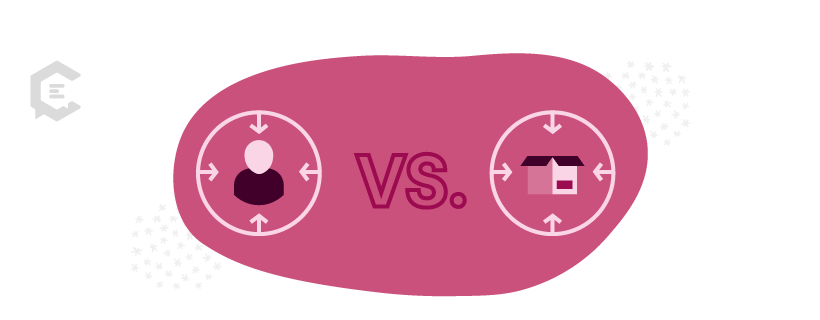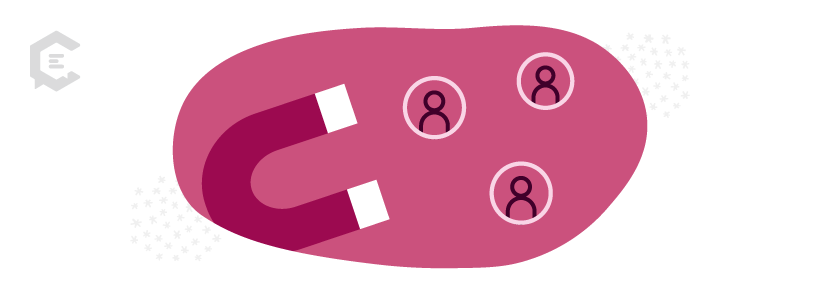Customer marketing within your content strategy is the key to creating a connection with your target audience that leads to conversions.
But what exactly is customer marketing? And how do you create one that will capture your target audience’s attention?
In this guide, we walk you through a step-by-step process to create a customer-centric content strategy that increases audience engagement and drives your success.

Customer-centric vs. Product-centric Content
The first step to creating a customer-centric content strategy is understanding the difference between a customer-centric and product-centric focus. A product-centric focus means your content is about your product or service. You talk about how great it is, how it’s different from the competition, and how it will benefit the reader.
On the other hand, a customer-centric focus means that your content is all about the customer. You talk about their needs, interests, and how your product or service can help them solve problems or improve their lives.
To see why this is such an important distinction, we have to answer this question:
How Does Content Marketing Attract Potential Customers?
When your target customer types a query into Google, they’re not necessarily looking for a product or service — they may not even know that your product or service exists.
Instead, they are looking for an answer to a problem or information on a topic they’re interested in. In fact, about 80 percent of search queries are informational in nature, while only 10 percent are looking for a product or service (the remaining 10 percent are looking for specific websites).
If your target customers want to find your content, you need to create content that answers their research questions.
Creating a Customer Marketing Strategy
Here are six steps to creating content marketing that will attract customers.
Step 1: Refine your target market
The key to succeeding in content marketing and customer engagement is to create content that makes your target market feel like you’re addressing them as individuals. You can’t do this if you don’t have a clear understanding of who your target market is.
If you’re unsure who your target market is, start by considering demographics — age, income, location, gender, and family status.
Many business owners resist targeting a specific niche because they feel like it’s limiting. They think, “Why not try to appeal to everyone?”
When you try to appeal to everyone, your marketing becomes too watered-down to be effective. Even products that seem to have a broad appeal often target specific demographics. For example, Coca-Cola doesn’t market to everyone — they target teens and young adults.
99 percent of marketers say personalization helps advance customer relationships. That’s a stat you can’t ignore.
Step 2: Know your customer’s needs
Once you know your target market, you’ll want to understand their needs. What are they looking for? What problems are they trying to solve when they type a query into a search engine? How can you help them?
You can find this information in a number of ways, including:
- Customer surveys
- Customer interviews
- Social media listening tools like Hootsuite, Insights, or Mention
- Google Ads Keyword Planner tool
Step 3: Develop buyer personas
Once you know your target market and their needs, you can start to develop buyer personas. A buyer persona is a semi-fictional representation of your ideal customer that considers their demographics, interests, pain points, and how they interact with your product or service.
Creating buyer personas helps you understand your target market on a personal level, so you can create content that resonates with them.
For example, suppose your company sells software that helps small businesses manage their finances. Your target market might be small business owners in the United States between the ages of 30 and 50. But within that target market, there are different types of customers with different needs.
You might develop the following buyer personas:
- Bob is a 35-year-old who has just bought a franchise for a fast-food restaurant. He has visions of expanding to own several restaurants. He’s great at food, marketing, and motivating his staff, but he struggles with understanding how to operate at a profit. He needs to get a handle on revenue and expenses.
- Jill is a 42-year-old who has owned her hair salon for 15 years. She’s good at cutting and coloring hair, but she hates dealing with the business side of things. She wants to spend more time with her family and less time managing bookkeeping, payroll, and taxes.
- Rob is a 50-year-old who wants to sell his software company and retire. He’s always gotten by with a shoebox full of receipts for taxes, but now he needs detailed reports to show potential buyers and auditors.
As you can see, buyer personas make it easier to relate to your target audience and understand their needs. And those needs guide the content you create.
Step 4: Map your customer journey
There’s a tight relationship between content marketing and the customer journey. To create content that resonates with your target market, you need to understand how they interact with your product or service — from their very first interaction (the awareness stage) all the way through to becoming a paying customer (the purchase stage).
To map your customer journey, think about each stage of the relationship between your customer and your product. For example, the customer journey for our accounting software company might look like this:
- Awareness: The customer becomes aware that they have a problem that needs to be solved
- Research: The customer starts researching solutions to their problem
- Comparison: The customer compares different products and decides which one is the best fit for their needs
- Purchase: The customer buys the product and becomes a paying customer
- Retention: The customer continues to use the product and may become an advocate or ambassador, referring new customers to your business
Once you’ve mapped out the customer journey, you can start to think about what type of content is most appropriate for each stage.
For example, in the awareness stage, your goal is to make your target market aware of the problem they need to solve. So, you might create blog posts, infographics, or ebooks that educate them about solutions to their problems.
In the research stage, your goal is to help your target market research different solutions to their problem. You might create blog posts, webinars, or ebooks that compare different products and help them make informed decisions.
And in the purchase stage, your goal is to convince your target market to buy your product. You might create case studies, product demos, or free trials.
Thinking about what type of content is most appropriate for each stage will help you generate plenty of ideas in the next step.
Step 5: Brainstorm keyword ideas
Here’s where the customer marketing part of the equation comes in: Instead of writing posts about your product’s features, you want to anticipate the keywords Bob, Jill, and Rob might type into a search engine to solve their problems.
Their questions might look like this:
- How to make a franchise more profitable
- How to manage finances for a small business
- How to make bookkeeping easier
- How to create a balance sheet for a small business
- What is a P&L statement?
Notice how these questions differ from “What is the best accounting software for a small business?” And yet, answering these questions gives you plenty of space to discuss your features and sell your product.
Research which of these questions might be high-ranking keywords and build your content calendar around them. Some of the tools you can use to research keywords include:
Step 6: Create valuable, informative content
Now that you know your target market and their needs, you can start creating content that meets those needs.
Remember, your goal is to create valuable and informative content and not just create another sales pitch for your product. High-quality content can help you improve your click-through rate, generate more backlinks, and provide a great user experience.
If you do it right, your content will attract potential customers to your website and will help build trust with them. Once they know, like, and trust you, they’ll be more likely to buy from you.
Take the Next Step
Creating a customer marketing strategy within your content strategy can be time-consuming and challenging, but it’s worth the effort. By creating informative, valuable content, you’ll not only attract new customers, but you’ll also build trust and credibility with your target market.
If no one on your staff is available to produce engaging, SEO-optimized content, talk to a content specialist at ClearVoice. We can help you find qualified freelance writers or develop a fully-managed content marketing solution that will attract new customers and help you achieve your business goals.








